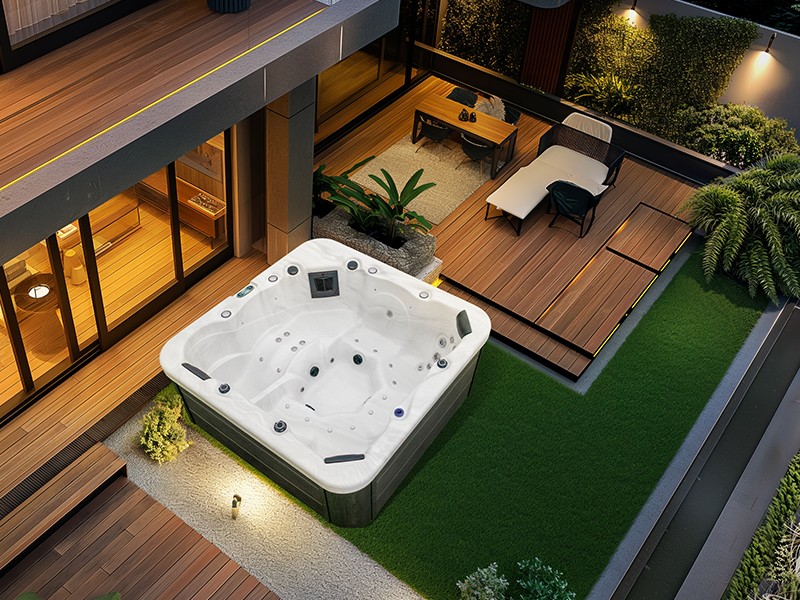
What is the life expectancy of an outdoor hot tub heater?
2024-11-06 15:30Outdoor hot tubs have become an important part of many homes, providing a private space for comfort and relaxation. Whether soaking in the cold winter or enjoying the warm water at night, the hot bathtub experience is enjoyable. However, the core of the hot tub's ability to provide users with a comfortable experience is its heater - a key device responsible for keeping the water temperature constant and providing continuous heating.
Understanding the life expectancy of an outdoor hot tub heater is essential for users to plan equipment maintenance and replacement. So, how long can a heater last? What factors affect the life of a heater? How can you extend its service life? This article will analyze these issues in detail to help you better understand and manage the life of a hot bathtub heater.
How does an outdoor hot bathtub heater work?
The heater is the key device in a hot tub responsible for heating the water to a predetermined temperature. Usually, it is powered by electricity, converting electrical energy into heat energy, and raising the water temperature to the temperature set by the user through a built-in heating element.
The heater usually consists of the following parts:
1. Heating element: directly responsible for heating the water flow, generating heat through electricity
2. Temperature sensor: detects water temperature and transmits data to the control system to control the working state of the heater.
3. Water flow sensor: ensures that the heater starts when the water flow is sufficient to avoid overheating.
4. Controller: connects to the user's control panel to help set the target temperature.
The heater will run when the water pump is turned on and adjust as the temperature changes to keep the water temperature constant. Because the heater needs to work for a long time and is often in a humid and temperature-variable environment, its life is closely related to the frequency of use of the device, environmental conditions and maintenance.
What is the expected life of the heater?
Typically, the life expectancy of outdoor hot tub heaters is between 5 and 10 years. This is an average life range, and specific situations may vary depending on a variety of factors.
The life of a high-quality heater
Some high-end hot tub heater manufacturers use durable materials and advanced technology to produce heaters that may last 10 years or even longer under ideal maintenance conditions. High-quality heating elements, better corrosion protection and more sophisticated control systems can extend the life of the heater.
The life of an ordinary heater
The life of a heater in the mid-price range is generally between 5 and 7 years. These heaters tend to use standard materials and are suitable for most consumers, but they may have a shorter lifespan under more intensive use and harsh external environments.
Lifespan of Low-End Heaters
Some economy or low-cost heaters may only last 3 to 5 years of normal use. These heaters are more basic in material selection and often lack corrosion resistance or efficient heating elements. If not properly maintained, heater failure may occur earlier.
It is important to note that even the same type of heater may have different lifespans depending on usage. Daily maintenance, cleaning frequency, water quality control, etc. can have a significant impact on the lifespan of the heater.
What are the key factors that affect the lifespan of heaters?
The life expectancy of a heater is not fixed and is affected by many external and internal factors. Here are some of the main factors that may affect the lifespan of a heater:
Water Quality
Water quality is an important factor affecting the lifespan of a heater. Especially in hard water areas, the water is rich in minerals such as calcium and magnesium, which can accumulate on the heating elements and form scale. Scale can hinder the efficiency of the heating element's heat transfer, causing the heater to work harder and increase energy consumption, which can significantly shorten the life of the heater over time.
In contrast, using soft or properly treated water can significantly reduce scale formation, thereby extending the life of the heater. Regular water quality testing and the use of appropriate chemical treatment agents to control the water's pH and balance the mineral content are essential to extend the life of the heater.
Frequency of Use
The life of the heater also depends on how often it is used. A hot tub that is used frequently will run the heater for a long time, which will increase the wear and tear on the heating element. In the case of high-frequency use, the life of the heater may be lower than those of less frequently used units.
For example, a user who uses the hot bathtub for a few hours a day may find that the heater fails after 4 to 5 years, while a user who uses it a few times a week may extend it to more than 7 years. Therefore, the frequency of use directly affects the life of the heater.
Environmental Factors
The environmental conditions that an outdoor hot tub faces also play a vital role in the life of the heater. For example, cold climates and frequent temperature changes can have a negative impact on the heater, especially if it is not adequately protected when not in use. Extreme temperatures can cause the heating element to expand or contract excessively, increasing the likelihood of fatigue and breakage.
In addition, hot tubs exposed to moisture or salt spray may experience premature aging of the heater due to corrosion. Improper moisture and corrosion protection can significantly shorten the life of the heater. Therefore, proper protective measures, such as using a hot tub cover or temporarily shutting down the unit during extreme weather conditions, can effectively reduce damage to the heater from the external environment.
Maintenance
The daily maintenance of the heater directly determines the length of its life. Regular cleaning of the heating element, checking the status of the line connection, and removing scale and other impurities can extend the life of the heater.
Most users ignore the importance of regular inspections and maintenance, especially when the heater is working properly. However, neglecting maintenance will allow small problems to accumulate gradually, eventually leading to premature damage to the heater. For example, if scale accumulates for a long time, it will cause the heating element to overheat and shorten its service life. Regular maintenance can not only extend the life of the heater, but also improve heating efficiency and save energy.
Electrical problems
The heater needs to be powered by electricity, and electrical problems may also affect its life. Voltage fluctuations, poor wiring, or short circuits can damage heating elements and other electrical components, especially if current protection devices are not installed.
If the voltage is unstable or the current load is too high, it may cause the heater to age prematurely or even burn out. Therefore, ensuring the stability of the electrical system and installing appropriate current protection devices for the heater are important measures to extend its service life.
What are the signs of a damaged heater?
During the use of the heater, there may be some warning signs that the heater is about to or has been damaged. Users need to always pay attention to these signs so that they can take timely actions to avoid further damage to the equipment or affecting the user experience.
The water temperature does not rise
If the water temperature of the hot bathtub cannot reach the set temperature, even if the heater has been running for a long time, it may mean that the heater has failed. The water temperature does not rise is one of the common signs of a damaged heating element or sensor failure.
Frequent temperature fluctuations
If you find that the water temperature fluctuates greatly, sometimes too hot and sometimes too cold, it may indicate a problem with the control system or thermostat inside the heater. The coordinated failure between the temperature sensor and the heating element usually causes this phenomenon.
Unusual heater noise
Under normal circumstances, the heater should operate quietly, and there may be a slight hum occasionally. However, if you hear unusual noises coming from your heater, such as a shrill squeal, metallic rubbing, or vibration, this could mean that there is a problem with the internal components, such as a worn heating element or loose parts.
Tripping or power outages
If the circuit trips every time you turn on the hot tub, there may be an electrical problem with the heater. This can be caused by a short circuit, incorrect wiring, or damage to the heater itself. Frequent power outages not only affect the user experience, but can also damage the heater and other electrical components.
How to extend the life of the heater?
First, clean the scale regularly, especially in hard water areas. Regularly removing scale from the heating element can effectively prevent reduced heating efficiency and excessive wear on the element. Second, maintain water balance. Regularly test and adjust the water in the bathtub to ensure the pH, alkalinity, and hardness are appropriate to reduce corrosion and scale accumulation on the heating element.
It is also important to note that in areas with unstable voltage, install a voltage stabilizer or circuit breaker to ensure that the heater operates under appropriate power conditions and avoid electrical failures. Then, check the heater's electrical circuit every few months to ensure that there are no problems such as short circuits, loose wiring, or corrosion. Turn off the heater when it is not in use to avoid long-term high-load operation and extend its service life.




